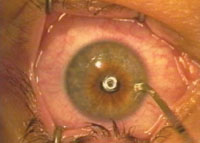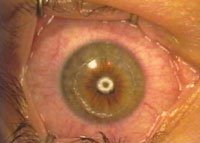Manual LASEK without the use of alcohol can be performed in selected cases
In eyes in which the epithelium is more tightly adherent to the stroma, a 10% alcohol solution can be used.
PARIS – Laser epithelial keratomileusis can be performed manually but without the use of alcohol in selected cases, according to a surgeon speaking at the annual meeting of the French Society of Cataract and Refractive Surgery held during the French Society of Ophthalmology meeting.
“The adherence of the epithelium to the stroma is extremely variable, and I found that there are quite a few eyes from which it can be detached easily with simple instruments. I test epithelial adherence at the beginning of the procedure, and if it is too tight, I use a mild 10% alcohol solution,” said Thierry Bour, MD.
Simple, safe and inexpensive
Surface refractive surgical procedures such as LASEK and PRK have been regaining popularity in the past few years, as they seem better suited for custom treatment, Dr. Bour said. LASEK has reduced the risk of the major concerns of PRK, namely haze and postoperative pain, he said. However, the potentially toxic effects of the alcohol used to detach the epithelium have been a cause of concern for some surgeons. Hence, alternative methods of automated epithelial sheet separation, which use special epithelial microkeratomes such as the Centurion Epi-Edge epikeratome (Norwood Abbey Ltd.) and the Epitome epi-LASIK system (VisiJet), were developed, he said.
“These systems do work, but they have the disadvantage of being extremely expensive. My technique, which I have named LASEKSAM (LASEK sans alcohol manuel, in French), is simple, safe and inexpensive, and takes into account the variability of epithelial adhesion in patients’ eyes,” Dr. Bour said.
The procedure
According to Dr. Bour, surgery begins with the surgeon marking the epithelium using a simple marker around the treatment area. The epithelial flap is cut along this line using a sharp microtip needle. With the same instrument, Dr. Bour tests the adherence of the epithelium along the edge.
“By testing epithelial adherence we can select the cases in which the flap can be performed without using the alcohol. I start at the point where the epithelium is more loosely attached and lift the edge with a spatula. Then I penetrate under the flap with a larger spatula and progressively separate the epithelial flap from the stromal bed,” Dr. Bour explained.
He noted that the epithelial flap obtained with this method is thinner and more delicate than LASEK flaps. Once lifted, it dries up quickly, and it should be moistened and protected with a drop of viscoelastic, he said.
Photoablation is performed as normal, then the cornea is irrigated and the flap is repositioned.
“This maneuver can also be slightly cumbersome because the flap is very thin and might get torn. However, even if the flap is not perfect, it will give the cornea enough protection as long as the center is covered,” Dr. Bour pointed out.
At the end, a soft contact lens is applied and left in place for 4 days.
Dr. Bour noted that corneas treated with this method look clear and transparent at day 1. Compared with LASEK, there was less epithelial exfoliation, and the viability of the epithelial cells was apparent, he said.
“At the beginning of the learning curve, this method of creating the flap manually and without alcohol takes 5 to 10 minutes. With more experience, 3 to 5 minutes is sufficient. We are now working at perfecting LASEKSAM instrumentation,” Dr. Bour said.
|
|
| (Images: Bour T) | |
A lower concentration
In cases in which the epithelium is too tightly adherent to perform the LASEKSAM procedure, Dr. Bour uses alcohol at a lower concentration than the usual 18% to 20%.
“A 10% concentration is sufficient to detach the epithelium, but you need to leave it in place for 1 minute rather than the usual 30 seconds. This is because the lower alcohol content makes the solution less capable of penetrating the tissues down to the stromal layer. On the other hand, a 10% solution causes no damage to the epithelium, which looks just like it does in the procedure without alcohol and very different from the epithelium which has been detached with an 18% alcohol solution,” Dr. Bour noted.
Over the past 6 months he has performed LASEKSAM without alcohol in about 15 patients and with 10% alcohol solution in about the same number of cases.
A clinical study comparing the results of LASEKSAM without alcohol or with a 10% alcohol solution to LASEK with 18% alcohol solution is currently ongoing, he said.
For Your Information:
- Thierry Bour, MD, can be reached at 60 rue Serpenoise, 57000 Metz, France; fax: 33-3-87-18-83-94; e-mail: thbour@wanadoo.fr. Dr. Bour has no financial interest in the products mentioned in this article.
- Michela Cimberle is an OSN Correspondent based in Asolo, Italy.


